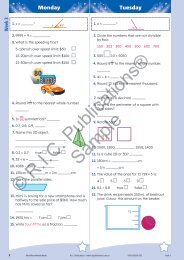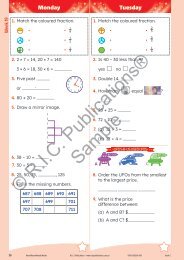RIC-3531 Primary Science - Book D (Digital)
You also want an ePaper? Increase the reach of your titles
YUMPU automatically turns print PDFs into web optimized ePapers that Google loves.
Changing Matter<br />
Changing States – Activity 2<br />
Lesson Focus<br />
Outcomes<br />
Natural and Processed<br />
Materials<br />
2.12 Distinguishes between<br />
changes that can not be<br />
readily reversed and those<br />
that can.<br />
Indicators<br />
• Identifies changes in<br />
materials using the<br />
senses.<br />
• Distinguishes changes<br />
in matter that can and<br />
cannot be reversed.<br />
• Conducts simple tests<br />
to observe and record<br />
changes in matter<br />
• Records and discusses<br />
observations during<br />
investigations.<br />
Skills Focus<br />
• Identifies<br />
• Records<br />
• Classifies<br />
• Follows a procedure<br />
• Investigates<br />
Background Information<br />
Everything we see and touch is<br />
matter. Sometimes we can see<br />
and feel matter and sometimes<br />
we can’t. Matter is all around us<br />
and exists as a solid, liquid or<br />
a gas. Most matter can change<br />
from one state to another<br />
when it is heated or cooled.<br />
Some matter, like water, can<br />
be easily changed from a solid<br />
to a liquid, or a liquid to a gas<br />
and back again. It may be ice,<br />
steam or water vapour, but it is<br />
still water.<br />
Water is one of the few<br />
substances that can change<br />
states and not be permanently<br />
changed. Other substances<br />
may react to heating or cooling<br />
but the changes are not<br />
reversible (e.g. burning paper<br />
to ash, cooking an egg). When<br />
water is warmed it evaporates<br />
(as a gas into the air). When<br />
warm air touches something<br />
cold it condenses and becomes<br />
a liquid.<br />
Before the Lesson<br />
Materials Needed<br />
Apple, potato, rock, three pieces of steel wool, two small sealable or snap-lock plastic bags,<br />
glass of water, measuring cup, plates, tablespoon, string, balloon, electric frying pan with lid,<br />
ice cubes.<br />
Preparation<br />
• The experiment can be prepared four days prior to the lesson to allow changes in materials<br />
to occur, or make observations on day of preparation as Day 1 of observations and leave gaps<br />
between observation days or extend observation time.<br />
• Select an observation table or part of the classroom where samples can be observed safely.<br />
The Lesson<br />
Stimulus<br />
• (Adult-directed activity.) Demonstrate changes of state in water by heating a frying pan.<br />
Place in ice cubes and allow students to observe the change to liquid. This activity can be<br />
timed. Turn up the heat and watch the water boil. Notice the steam rising into the air. Ensure<br />
students are standing away from the table. Demonstrate how the steam is really water<br />
droplets by holding a lid carefully over the steam and watch the steam turn to water droplets<br />
and return to the pan (condensation). Boil the water until the pan is empty (evaporation).<br />
The air is now filled with invisible water vapour produced from icecubes. Revise and discuss<br />
the changes that occurred from the ice block to water vapour. Look at the ice cube. Is it a<br />
solid or liquid? When water gets very cold it freezes and when it gets warm it melts into a<br />
liquid. When water is heated it becomes steam, which will condense back into water.<br />
What to Do<br />
• Cut up the apple and potato into pieces and leave on a plate. (The whole apple or potato may<br />
not be needed, depending on size.)<br />
• Blow up a balloon and tie it with a string to something so it can’t float away. Measure its<br />
circumference each day.<br />
• Put a cup of water into the measuring cup. Measure its volume each day.<br />
• Put one piece of steel wool in a plastic bag with three tablespoons of water and seal the bag.<br />
(Try to remove any air.)<br />
• Put one piece of steel wool in a plastic bag with three tablespoons of water and leave it open.<br />
• Put the third piece of steel wool in a dry place where it can’t be touched.<br />
• Put the rock and all the above substances in a safe observation area.<br />
• Students observe and record the changes each day for five days.<br />
• Discuss and describe the changes that have occurred and record the results over the selected<br />
observation day. What do you think has happened to the samples to cause changes (e.g. lost<br />
air, exposed to air, evaporated)?<br />
After the Lesson<br />
Answers<br />
The potato and apple rotted and changed colour – they are not the same any more.<br />
The water evaporated.<br />
The dry steel wool had no change. The rock did not change.<br />
The wet steel wool in the open bag allowed air in and rusted, because iron turns to rust<br />
when exposed to oxygen and moisture.<br />
The wet steel wool that wasn’t exposed to the air should have stayed a similar shape.<br />
The balloon didn’t change but got smaller and went limp as some air escaped. However it<br />
was still a balloon.<br />
Additional Activities<br />
• Study the water cycle. Discuss how water is recycled and a precious resource to our Earth.<br />
• Collect and test other materials to observe changes in matter. (Burning a match, candles,<br />
cooking an egg, etc.) Make a list of irreversible changes.<br />
Display Ideas<br />
• Display objects on a ‘safe’ table. The students can create a large version of the blackline using<br />
coloured card. The results can be transferred to the new chart and extra information about<br />
the students’ observations can be attached (written and presented by the students).<br />
44 PRIMARY SCIENCE ~ R.I.C. Publications ® ~ www.ricpublications.com.au<br />
ISBN 978-1-925660-54-8<br />
©R.I.C. Publications<br />
Low Resolution Images<br />
Display Copy


















